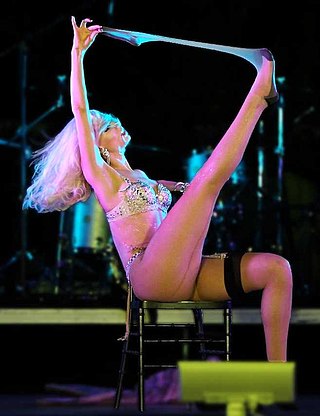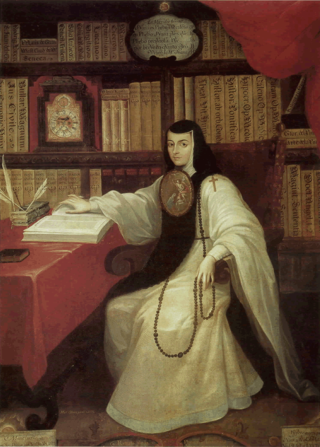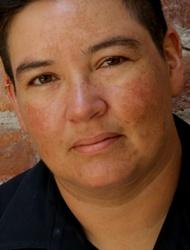
A striptease is an erotic or exotic dance in which the performer gradually undresses, either partly or completely, in a seductive and sexually suggestive manner. The person who performs a striptease is commonly known as a "stripper" or an "exotic" or "burlesque" dancer.

Juana de Asuaje y Ramírez de Santillana, better known as Sor Juana Inés de la Cruz, was a colonial Mexican writer, philosopher, composer and poet of the Baroque period, as well as a Hieronymite nun, nicknamed "The Tenth Muse" and "The Phoenix of America" by her contemporary critics. As a Spanish-criolla from the New Spain, she was amongst the main American-born contributors to the Spanish Golden Age, alongside Juan Ruiz de Alarcón and Garcilaso de la Vega "el Inca", and presently considered one of the most important female authors in Spanish language and Mexico's literary history.

Vaginal Davis is an American performing artist, painter, independent curator, composer, filmmaker and writer. Born intersex and raised in South Central, Los Angeles, Davis gained notoriety in New York during the 1980s, where she inspired the Bushwick neighborhood of Brooklyn's prevalent drag scene as a genderqueer artist. She currently resides in Berlin, Germany.
Guadalupe Teresa Amor Schmidtlein, who wrote as Pita Amor, was a Mexican poet.

Gayle S. Rubin is an American cultural anthropologist, theorist and activist, best known for her pioneering work in feminist theory and queer studies.

José Esteban Muñoz was a Cuban American academic in the fields of performance studies, visual culture, queer theory, cultural studies, and critical theory. His first book, Disidentifications: Queers of Color and the Performance of Politics (1999) examines the performance, activism, and survival of queer people of color through the optics of performance studies. His second book, Cruising Utopia: the Then and There of Queer Futurity, was published by NYU Press in 2009. Muñoz was Professor in, and former Chair of, the Department of Performance Studies at New York University's Tisch School of the Arts. Muñoz was the recipient of the Duke Endowment Fellowship (1989) and the Penn State University Fellowship (1997). He was also affiliated with the Modern Language Association, American Studies Association, and the College Art Association.
Heather MacAllister was an American burlesque performer and social justice activist, whose work covered anti-racism, LGBT rights, and especially the fat acceptance movement. MacAllister performed on stage as Reva Lucian, a play on 'revolution', and Ms. Demeanor.

Jesusa Rodríguez is a Mexican theater director, actress, performance artist, social activist, elected Senator of the Morena party and an active promoter of the use of marihuana and other drugs. Active representative of the LGBT community.

María del Carmen Mondragón Valseca, also known as Nahui Olin, was a Mexican painter, poet, and artist's model.

A vedette is the main female artist of a show derived from cabaret and its subcategories of revue, vaudeville, music hall or burlesque. The purpose of the vedette is to entertain and captivate the public. Vedettes are expected to sing, dance and act on stage. Particularly accomplished artistes are considered super vedettes or first vedettes. Vedettes often appear alongside groups of dancers, flashy and revealing costumes, magicians, comedians, jugglers, or even performing animals. Vedettes specializing in burlesque generally do striptease and may also perform nude on stage.
Amber L. Hollibaugh is an American writer, filmmaker and political activist, largely concerned with feminist and sexual politics.
Laura Aguilar was an American photographer. She was born with auditory dyslexia and attributed her start in photography to her brother, who showed her how to develop in dark rooms. She was mostly self-taught, although she took some photography courses at East Los Angeles College, where her second solo exhibition, Laura Aguilar: Show and Tell, was held. Aguilar used visual art to bring forth marginalized identities, especially within the LA Queer scene and Latinx communities. Before the term Intersectionality was used commonly, Aguilar captured the largely invisible identities of large bodied, queer, working-class, brown people in the form of portraits. Often using her naked body as a subject, she used photography to empower herself and her inner struggles to reclaim her own identity as “Laura”- a lesbian, fat, disabled, and brown person. Although work on Chicana/os is limited, Aguilar has become an essential figure in Chicano art history and is often regarded as an early "pioneer of intersectional feminism” for her outright and uncensored work. Some of her most well-known works are Three Eagles Flying, The Plush Pony Series, and Nature Self Portraits. Aguilar has been noted for her collaboration with cultural scholars such as Yvonne Yarbo-Berjano and receiving inspiration from other artists like Judy Dater. She was well known for her portraits, mostly of herself, and also focused upon people in marginalized communities, including LGBT and Latino subjects, self-love, and social stigma of obesity.

Nao Bustamante is a Chicana interdisciplinary artist, writer, and educator from the San Joaquin Valley in California. Her artistic practice encompasses performance art, sculpture, installation, and video and explores issues of ethnicity, class, gender, performativity, and the body. She is a recipient of the 2023 Rome Prize.
TT Takemoto is an American artist and associate professor of visual studies and dean of Humanities & Sciences at California College of the Arts in San Francisco. Takemoto's work explores issues of race and queer identity. They have presented work internationally, and received numerous grants for their work, notably from ART Matters, the James Irvine Foundation and the San Francisco Arts Commission. Their film Looking for Jiro received Best Experimental Film Jury Award at the Austin LGBT International Film Festival, and opened MIX 24: New York’s Queer Experimental Film Festival.

Adela Vázquez is a Cuban American transgender activist and performer. Hailing from Cuba during a time of political uprising, Vázquez was one of 125,000 people who sought asylum and migrated in the Mariel Boat lifts in 1980. Local to San Francisco's gay scene, Vázquez began to organize with HIV prevention organization Proyecto ContraSIDA Por Vida and became a community activist for transgender rights.

Esta Noche was the first Latino gay bar in San Francisco and notably contributed to queer Latin culture. It operated from 1979 to 2014, and was located at 3079 16th Street between Valencia Street and Mission Street in San Francisco, California.

Juana María Rodríguez is a Cuban-American professor of Ethnic Studies, Gender and Women's Studies, and Performance Studies at the University of California, Berkeley. Her scholarly writing in queer theory, critical race theory, and performance studies highlights the intersection of race, gender, sexuality and embodiment in constructing subjectivity.

Kay Turner is an artist and scholar working across disciplines including performance, writing, music, exhibition curation, and public and academic folklore. She is noted for her feminist writings and performances on subjects such as women’s home altars, fairy tale witches, and historical goddess figures. She co-founded “Girls in the Nose,” a lesbian feminist rock punk band that anticipated riot grrl.

Marcia Ochoa is a United States-based professor of Feminist Studies and Critical Race and Ethnic Studies at the University of California, Santa Cruz. They are the co-founder of El/La Para TransLatinas and is credited with popularizing the term "translatina."

Chicana art as a specific genre emerged as part of the Chicano Movement of the 1960s and used art to express political and social resistance. Through different art mediums both past and contemporary, Chicana artists explore and interrogate traditional Mexican-American values and embody feminist themes through different mediums including murals, painting, photography, and more. The momentum created from the Chicano Movement spurred a Chicano Renaissance among Chicanas and Chicanos. Political art was created by poets, writers, playwrights, and artists and used to defend against their oppression and societal marginalization. During the 1970s, Chicana feminist artists differed from their Anglo-feminist counterparts in the way they collaborated. Chicana feminist artists often utilized artistic collaborations and collectives that included men, while Anglo-feminist artists generally utilized women-only participants.














